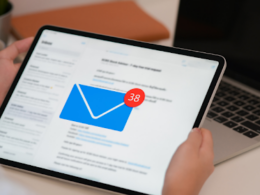Whether you’re a startup striving for visibility or an established business, the challenge of getting your products and services in front of your customers remains a constant. Developing a marketing strategy is pivotal in addressing this challenge. However, doing research the old-fashioned way can be daunting and time-consuming. Plus, it often yields limited insights, especially when faced with mountains of data.
Enter AI copilot: a powerful ally to transform your marketing strategy. Just like a copilot in an airplane assists the captain, this advanced artificial intelligence system assists users with various tasks, from data analysis and research to content creation and strategic planning. It uses large language models (LLMs) and natural language processing to help you make sense of complex data, identify patterns and trends, and generate actionable insights with unparalleled speed and accuracy.
This blog post will discuss the five ways AI copilots can empower businesses to create a winning marketing strategy that resonates with your target audience and drives growth.
Verizon Digital Ready: $10K Grants and the Skills Entrepreneurs Need
Five ways to use AI copilot to create a marketing strategy
1. Defining clear goals
Imagine you’re planning a road trip from New York to Los Angeles. If your only goal is to “drive across the country,” you’ll likely take a haphazard route with random stops, lacking purpose or efficiency. However, a clear objective such as “reach Los Angeles via the most efficient and scenic route” allows you to strategically map out your journey, plan stops, and maximize the experience.
When creating a marketing strategy, defining clear goals and objectives is akin to setting the destination for a road trip. Without a clear endpoint in mind, you’ll find yourself aimlessly wandering, wasting time and resources, and missing out on opportunities along the way.
Setting clear objectives from the outset allows you to create a focused marketing strategy that aligns your efforts towards a common purpose, maximizing the chances of reaching your desired destination — whether it’s increased brand awareness, improved lead generation, or boosted sales and revenue. Further, you can use these goals as benchmarks to course-correct your marketing strategy as needed, pivoting or doubling down on specific tactics based on their performance.
An AI copilot can be a powerful companion in helping you set well-defined, achievable objectives for your marketing efforts. Just as you use AI search for workplace to set specific criteria and objectives when searching for talent, defining clear goals using AI copilots helps you identify the most relevant and impactful initiatives to achieve your desired outcomes.
For example, if your goal is to increase brand awareness, your AI copilot can analyze market trends, competitor strategies, and consumer behavior to recommend specific objectives such as:
- Increase brand mentions by 30% on social media platforms within six months.
- Double website traffic through search engine optimization (SEO) efforts within three months.
- Achieve a 20% increase in email open rates by implementing personalized email marketing campaigns within six months.
- Improve customer engagement by 25% on the company’s mobile app within a year.
With an AI copilot, you can set precise and achievable goals based on data-driven insights rather than relying solely on intuition or past experiences. Further, an AI copilot can assist in breaking down goals into specific, measurable objectives, complete with key performance indicators (KPIs) and target metrics. This ensures your marketing goals are realistic and aligned with your organization’s broader business objectives.
Sign Up for The Start: A Newsletter Built for Entrepreneurs
2. Conducting market research
Market research is the heart of any successful marketing strategy.
While planning a road trip to a new destination, you’d want to gather information about the route, road conditions, weather forecasts, and interesting stops along the way.
Similarly, when creating a marketing strategy, conducting market research is crucial to gather insights about your target audience, market trends, competitors, and industry landscape. It helps you navigate your way to success by making informed decisions based on data rather than guesswork.
An AI copilot can be an invaluable asset in this process, allowing you to gather and analyze tons of data from various sources quickly and efficiently. It’s like having a skilled navigator who can provide real-time updates, alternative routes, and valuable insights — enhancing your road trip experience.
Let’s say you’re launching a new SaaS product designed to streamline project management for remote teams. As part of your content marketing strategy, you decide to create step-by-step guides that address common pain points and challenges faced by remote teams, such as optimizing workflows, enhancing collaboration, and increasing productivity.
Your AI copilot can analyze market trends and customer behavior to pinpoint the most sought-after topics in remote work, preferred content formats (like written guides, video tutorials, or infographics), and optimal distribution channels. Further, these tools can examine social media conversations, customer reviews, and online behavior to gain deep insights into consumer preferences, sentiment, and emerging trends. And, study competitor marketing strategies, product offerings, and pricing models, helping you identify opportunities and potential threats.
What’s more, you can leverage the AI copilot to analyze user feedback to announce SaaS updates effectively, ensuring that your audience is always informed about new features and improvements.
3. Identifying target audiences
Just as you wouldn’t set out on a trip without knowing your destination, you can’t effectively market your products or services without a clear understanding of who you’re trying to reach. So, once you have a comprehensive understanding of the market, it’s time to identify your target audience and create detailed personas.
It involves understanding the characteristics, preferences, and behaviors of the individuals most likely to engage with your brand.
With an AI copilot, identifying target audiences shifts from a time-consuming, manual guesswork to a precise, data-driven analysis. It’s like having expert detectives equipped with advanced tools to uncover hidden clues and patterns in vast amounts of data.
Here’s how AI copilots can help:
- AI copilots analyze demographic data like age, gender, location, income, and occupation to identify target segments and craft detailed customer profiles for strategic marketing.
- Using behavioral analysis, AI copilots track online interactions and browse the habits and purchasing behaviors of potential customers. They identify potential customers showing interest in your offerings based on their engagement with content, products, and brands.
- AI copilots leverage machine learning algorithms to identify patterns and correlations in customer data. For example, AI can identify common traits among your most loyal customers or predict which leads are most likely to convert into sales.
- AI copilots analyze sentiment across social media platforms, customer reviews, and other online channels to gauge how people feel about your brand and products. This understanding helps tailor marketing messages to resonate with customer emotions and preferences.
Picture this: you’re opening an artisanal bakery specializing in gluten-free treats. The AI copilot could analyze data on consumer interests, lifestyle choices, and purchasing behaviors to identify a potential target audience that prioritizes healthy, allergen-friendly options.
With this level of granular insight, you can craft marketing messages and campaigns that resonate deeply with this specific group, increasing the likelihood of capturing their attention and driving conversions.
What’s more, the AI copilot can continually monitor and update its understanding of your target audiences as new data becomes available. This ensures your marketing strategy remains agile and responsive to evolving consumer trends and market shifts.
Level Up Your Digital Skills: Free This Week with Verizon Small Business
4. Examining the 4 Ps
In marketing, the four Ps—Product, Price, Place, and Promotion—are the essential ingredients that shape your marketing strategy. Understanding these can help you build a cohesive plan that addresses the unique needs and preferences of your target audience, position your offering competitively, and leverage effective tactics to drive awareness and sales.
However, if you want to elevate your examination of the four Ps, AI copilots can help. These tools continuously monitor market dynamics, customer preferences, and competitive landscapes, providing real-time insights and recommendations for adjusting your four Ps as needed.
Let’s say you’re launching a new line of luxury watches. Here’s how you can examine each of the four Ps using AI copilots:
- Product: To ensure your watches meet the highest standards, AI tools analyze customer data, including reviews, surveys, and social media conversations, to uncover deep insights into your target audience’s needs, preferences, and pain points. Plus, it studies competitor offerings to fine-tune your watch features and design.
- Price: AI copilots leverage machine learning algorithms to analyze pricing strategies, competitor pricing, and consumer willingness-to-pay indicators to optimize your pricing strategy.
By crunching numbers and predicting market demand, the AI copilot can help you set prices that maximize profitability while remaining competitive in the market. Plus, it can recommend optimal pricing models, such as bundling, discounting, or premium positioning.
- Place: Choosing the right channels is crucial to reach your target customers and make your watches accessible to them. AI copilots excel at analyzing market segmentation, distribution channel performance, customer journey data, and geographic data to identify the most effective channels for your product — such as physical retail outlets, e-commerce platforms, or direct-to-consumer channels.
- Promotion: The next step is to promote your watches to your target audience. AI copilots leverage natural language processing capabilities to provide data-driven insights and predictive analytics. From identifying the most effective marketing channels to optimizing ad targeting and messaging, AI can help you craft personalized and impactful promotions that resonate with your target audience.
Conquering Business Development Challenges: 15 Insights from Startup Leaders
5. Continuously refining and adapting your strategy
During your road trip, you constantly monitor the road conditions, traffic patterns, and weather forecasts. If unexpected road closures arise or you encounter heavy traffic, you adapt your route accordingly, seeking alternative roads or adjusting your schedule to avoid delays.
Similarly, marketing strategies are not static — consumer preferences evolve, market trends shift, and new competitors emerge. Therefore, you must continuously adjust your marketing strategy to these changing market dynamics. It involves closely monitoring your campaign’s performance, analyzing data and metrics, and identifying areas that need improvement or new approaches that could yield better results.
Since an AI copilot is equipped with advanced technology and real-time data, it can assist you in this ongoing process. It can identify potential opportunities, threats, and areas for improvement that would be impossible to detect otherwise. This allows you to make informed decisions and pivot your marketing strategy as needed.
Let’s say you’re running a digital marketing campaign for a new mobile app.
Your AI copilot continuously tracks campaign performance metrics, such as click-through rates, conversion rates, and return on investment (ROI). It also monitors social media conversations, customer reviews, and app store rankings, providing you with valuable feedback and recommendations in real time.
If engagement metrics start to decline or competitor activity intensifies, your AI copilot alerts you to potential challenges and opportunities. It may suggest adjusting your targeting parameters, refining your messaging, or exploring new marketing channels to stay ahead of the curve.
Further, AI copilots use predictive analytics to anticipate future trends and market shifts. By analyzing historical data and external factors like economic indicators, AI helps you adapt your strategy proactively to seize opportunities and mitigate risks.
Summing up
From conducting in-depth market research and identifying target customers to monitoring and adjusting your marketing strategy — the AI copilot can assist you every step of the way.
However, an AI copilot is designed to enhance your capabilities, not replace human expertise and decision-making. By combining the data-driven insights and recommendations of an AI copilot with your industry knowledge, creativity, and strategic thinking, you can create a winning marketing strategy that sets your business apart from the competition.
Image by DC Studio on Freepik






